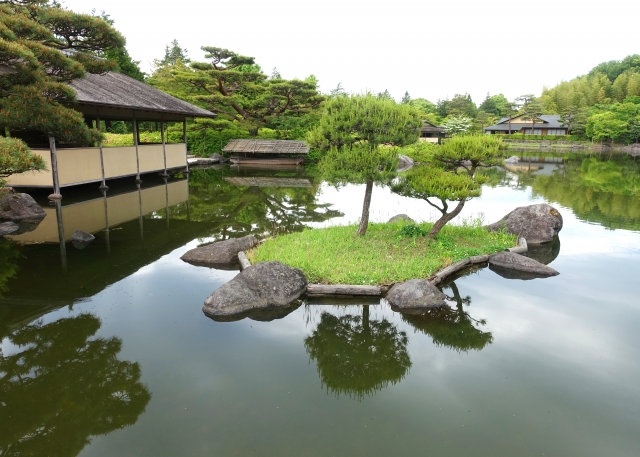Japanese gardens are a traditional Japanese culture that has been handed down from the Asuka (593 – 710) and Nara (710 – 794) periods to the present. The styles of Japanese gardens have changed with the passage of time.
The meaning of Japanese gardens and what people look for in Japanese gardens have also changed with the times. In other words, Japanese gardens have a history of change influenced by the thoughts of the Japanese people who lived in that era.
In addition, even today, Japanese gardens are very expensive. They are not easy to obtain. However, anyone can obtain a Japanese garden. However, this has been the case since the Meiji period. In the Heian Period, Japanese gardens were the privilege of the nobility and other upper classes, and after the Warring States Period, they were the privilege of the feudal lords. Ordinary people were not allowed to have the luxury of creating gardens.
Thus, Japanese gardens symbolize the history and culture of Japan, and are a valuable asset that has passed through the ages and has been handed down to the present.
Let us take a look at Japanese gardens by period.
The Asuka and Nara Periods, the Origins of Japanese Gardens
(~783)
Ancient people lived in harmony with nature and sometimes worshipped the nature around them as gods.
The origin of Japanese gardens can be traced back to this period, such as “Iwakura,” a rock formation where a giant stone was considered a place for a deity to descend, and pond of the Gods and island of Gods, ponds where sea deities were enshrined in ponds that were thought of as the sea.
In other words, the origin of Japanese gardens was the belief in nature.
Later, with the arrival of Buddhism, garden culture was introduced from the continent. Michinokono-Takumi, a visitor from Baekje at that time, built a bridge over a pond in the south garden of the court and installed a standing stone symbolizing Mount Sumeru, which rises at the center of the Buddhist world.
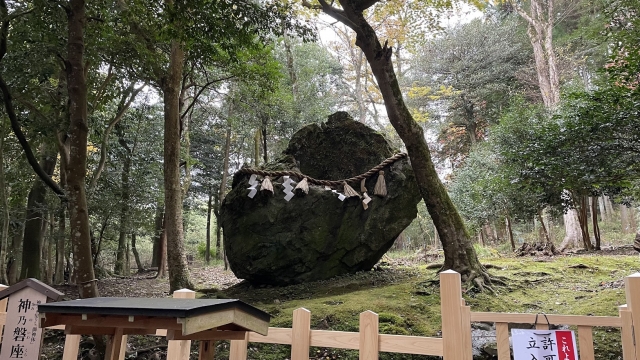
In addition, the Heijo Palace East Palace Garden, with its intricately shaped pond and fountain with an island in the middle, was a place to entertain guests from the continent and represented the advanced culture of the time. It was during this period that the Kyokusui garden, with its S-shaped channel, was introduced from the continent. The “Kyokusui no utage,” or a banquet at which people would recite a poem before the water flowed upstream and passed in front of them, was held actively in this S-shaped channel.
The Asuka and Nara periods were the period when the spirit of nature reverence of the ancient Japanese, combined with the introduction of Buddhism, laid the foundation for the development of Japanese gardens unique to Japan.

The Heian Period, a stronghold of the nobility(784~1184)
The capital moved from Heijo-kyo to Heian-kyo, and gardens continued the style of the Nara period, with ponds and pools, and kyokusui and yarimizu.
In the Heian period, Japanese gardens were integrated with the shinden-zukuri style of architecture. The temple-style garden was centered around a pond in the south, and the pond was connected to the temple by a walkway, at the end of which was a tsuridono (a space for cooling off) that protruded into the pond. The pond had three islands, called Sanjinseondao, and the middle island was connected by a bridge, and water was drawn from the northeast through a channel called Yarimizu.
The nobles enjoyed boating in the pond by floating their ryutougekishu (boats with a dragon and a gong, a water bird, at the head) on the spring.

Buddhism was introduced from the continent in the 6th century and was widely believed in during the Heian period, especially among the aristocracy.
Buddhist scriptures teach that 1,000 years after the death of Buddha, the founder of Buddhism, the world would be in disorder and that one would not be able to go to the Paradise. This is called the Latter Day of the Law philosophy.
The year 1052 in the late Heian period is regarded as the first year of the Latter Day of the Law because it falls exactly in this year.
Coincidentally, around this time, a war broke out in which monks turned into monk soldiers and killed each other. The nobles feared the coming of the Latter Day of the Law.
In such a time of the Latter Day of the Law, the only way to attain paradise was to vividly visualize the Pure Land of Ultimate Bliss in one’s mind, which is called “Kanso”.
However, it was difficult to easily visualize the Pure Land of Ultimate Bliss, so they came up with the idea of creating it right in front of our eyes.
The result is the Byodoin Garden, which is representative of the Pure Land style garden.
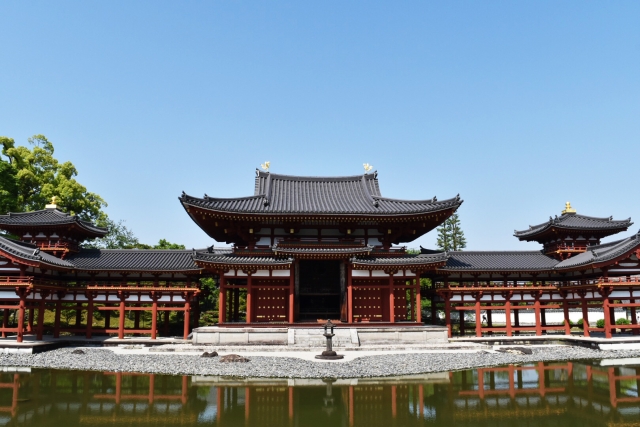
Samurai-centered Kamakura period(1185~1333)
During the Heian period, the aristocratic class ruled the country, whereas in the Kamakura period, the samurai claimed ownership of the farmland they cultivated and began to run the country.
The buildings changed from the large one-room temple style to the shoin style, in which the interior was divided into several independent rooms, each room was covered with tatami mats and had an alcove and other attached facilities.
The gardens also gradually changed, from the syuyu-style gardens of the Heian period to kaiyu-style gardens. The samurai class, which became the core of society, became devoted to the Zen teachings newly introduced from China and preferred to contemplate while walking around the garden as part of their Zen practice. The development of the shoin-style drawing room also led to the creation of gardens that could be viewed from the room.
Zen monks led the gardens of this period. Among them, Muso Kokushi, a Zen monk of the Rinzai sect, is credited with creating a waterfall arrangement without using water on the upper slope of Saiho-ji Temple, known familiarly today as moss-temple, which is called Early Karesansui, the origin of the later Karesansui style.
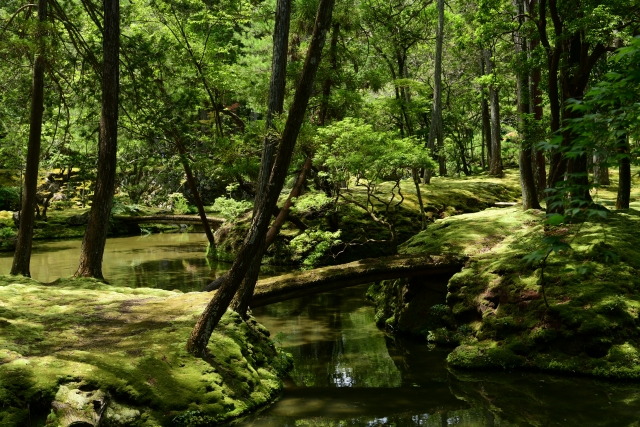
A new type of waterfall masonry created in the Kamakura period (1185-1333) is called “Ryumonbaku. Legend has it that a carp that climbs to the top of the three-story waterfall in the upper reaches of the Yellow River in China is transformed into a dragon. The legend of the dragon ascending the waterfall is based on this legend. The carp streamer is an event to wish for a boy’s success in life, in honor of this legend.Ryumonbaku is a waterfall stone arrangement with a carp-like stone in the center. This Ryumonbaku was continued in the Muromachi period (1333-1573). In the Kamakura period, the aristocracy-centered Heian period was replaced by the samurai-centered era, and at the same time, architectural styles and lifestyles changed, and the garden style also changed accordingly.

The Muromachi Period, when Japanese gardens blossomed.
(1334~1573)
Rokuonji Temple, commonly known as Kinkakuji Temple, and Jishoji Temple, commonly known as Ginkakuji Temple, are two of the most famous Japanese gardens of the Muromachi period.
Both of them were designed in the Pure Land style, centering around a pond with a central island, and combining the Chinese Taoist-influenced concept of “Shinsen Horai” (the Goddess of Mercy).
In this period, a turning point in the history of Japanese gardens was the emergence of karesansui, a type of dry landscape garden that expresses a landscape without using a single drop of water. It is called karesansui (dry landscape garden) of the later period.
Karesansui was a garden that symbolized the natural world as seen through the filter of the Zen world, using a very limited amount of stones and sand to symbolize space, so to speak.
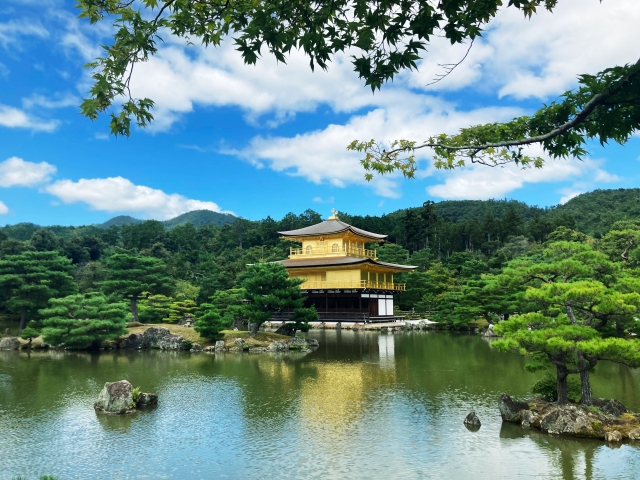
Many karesansui (dry landscape garden) styles express deep mountains and valleys, but the limited space does not allow for the creation of vast landscapes. Therefore, the landscape was reduced in size, and abstraction was promoted, for example, by using a single stone to represent a high mountain.
There are also gardens such as the Ryoanji Garden, which consists of only 15 stones placed on a rectangle of white sand, and the gravel can be seen as either a sea or a sea of clouds. From these gardens, it is said that the meaning is not limited to one meaning, but changes depending on how the viewer perceives the garden, making them attractive as gardens that reflect the human mind.
It can be said that the Muromachi period was a time when the garden philosophy inherited from past eras blossomed and developed into gardens with a variety of charms.
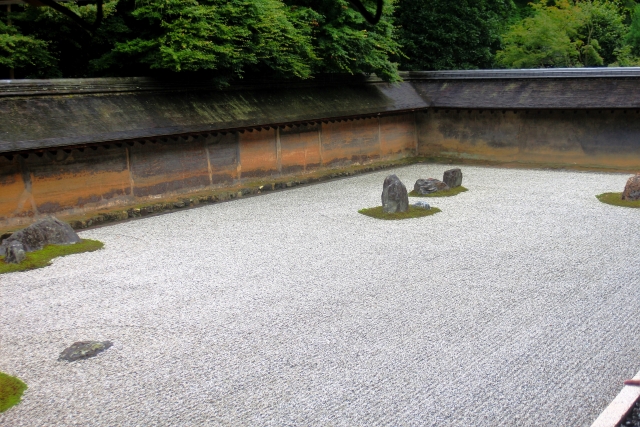
(dry landscape garden)
The Azuchi-Momoyama period, which symbolized the heavenly kingdom(1573~1600)
The Azuchi-Momoyama period was a period of warfare in which the three great warlords Oda Nobunaga, Toyotomi Hideyoshi, and Tokugawa Ieyasu fought for the unification of the country.
Art and architecture of the Azuchi-Momoyama period tended to inspire power. Large-scale castle towers emerged, and the use of gold, blue, and dark colors in barrier paintings became the norm.
Hideyoshi built such structures as Juraku-dai in Kyoto, Fushimi Castle, and Sanpoin Temple in Daigoji as symbols of his power. Thus, gardens of the Azuchi-Momoyama period at the end of the Warring States period were created in grand style as symbols of the power of feudal lords and military commanders.
Shinsenjima Island was built to express the belief of the Shinsen (Immortals) inherited from the Nara period (710-794). It was believed that immortal immortals lived on the island and that there was an immortality elixir. Therefore, a bridge was never built over the island because it was an unknown world that was inaccessible to man. However, in the Azuchi-Momoyama period (1568-1600), a bridge was built over the island because the warlords who lived through the turbulent days of the Warring States period considered Turtle Island and Crane Island, which represented the Immortal Island, to be a world they had entered, not something they could look at from afar.
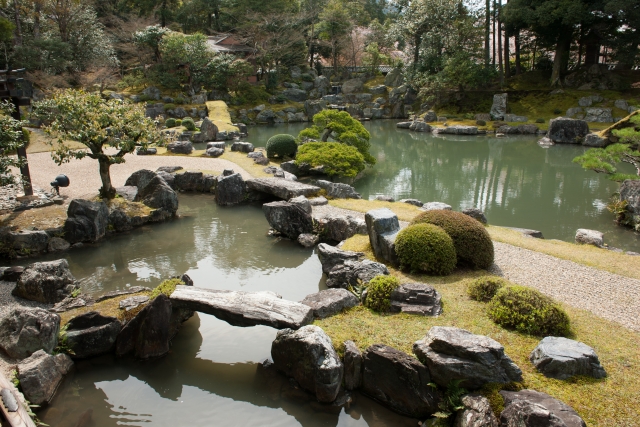
While the Azuchi-Momoyama period created gardens with gorgeous crane and turtle stone arrangements, it also produced tea gardens, which are gardens of wabi, sabi, and mysterious profundity.
The establishment of chanoyu is thought to have occurred at the end of the Muromachi period. In the Azuchi-Momoyama period (1573-1600), with the advent of Takeno-joo and his disciple Sen no Rikyu, who developed the wabicha style, independent hermitages and tea gardens began to be built.
The tea garden is also called roji, meaning a place where people walk along the path to the tea house. With the advent of the tea ceremony garden, stepping stones, stone wash basins, and lanterns were created, which are still essential elements of the tea ceremony garden today.
Town houses in Kyoto were so-called “eel beds,” with a narrow frontage and long depth. In the middle of this space, a lighted space was created, which was like a smaller version of an open-air garden, and was decorated with lanterns and handbasins. The cortyard was thus created as a small garden space.
The Azuchi-Momoyama period was a time of both the splendor of Japanese gardens created by warlords who had conquered the world, and the spirituality of Japanese gardens that emphasized the opposite, the simple taste.
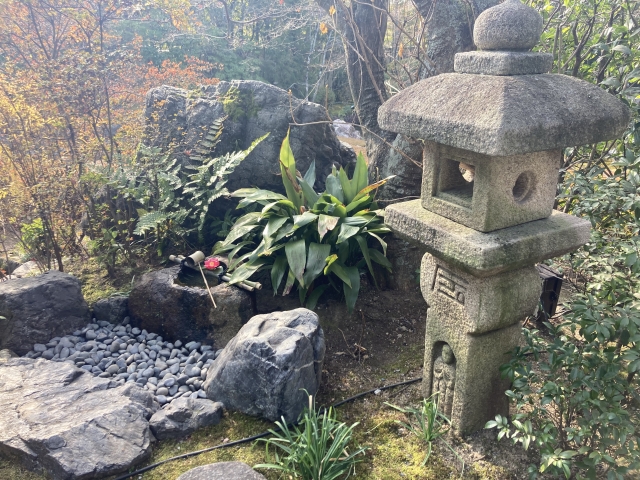
The Edo Period, which triggered a huge boom(1600~1868)
In the Edo period (1603-1867), the country entered a period of peace without warfare. A huge boom in landscaping occurred in Edo, the seat of the shogunate, and in castle towns across the country.
In Edo, the upper, middle, and lower residences of each clan were located, and a garden was created for each. The number of clans in Japan is said to be about 3,000, which means that there were nearly 1,000 clan residences in Edo. It can be said that Edo was indeed the world’s largest garden city.
Gardens created during the Edo period and associated with feudal lords are called “Daimyo-garden. Daimyo gardens are characterized by their large ponds and fountains.
In addition, some local clans had gardens that replicated the scenery they saw during their visits to their domains. Especially popular was the sacred Mt. A typical example can be seen in Suizenji Joujuen, the villa of the Hosokawa family of the Kumamoto domain.
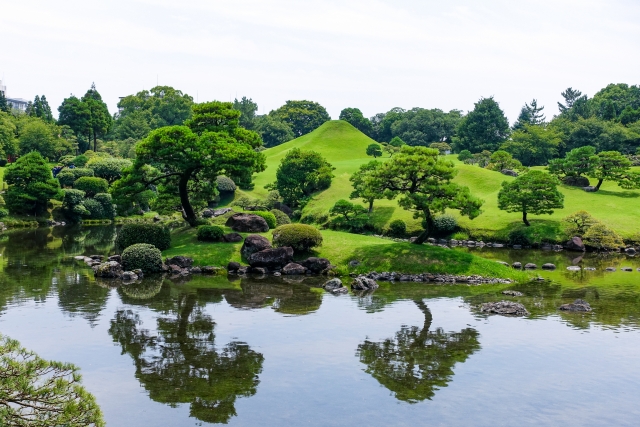
During the Edo period (1603-1868), Japanese garden culture was further developed against the backdrop of a peaceful world. It was a period when there were more Japanese gardens than at any other time in Japan’s history, when gardens began to be created all over the country. It is said that samurai residences accounted for about 70% of the gardens in Edo, in particular. If we assume that every samurai residence had a vast daimyo’s garden built, we can imagine that it was truly a lush and beautiful landscape.
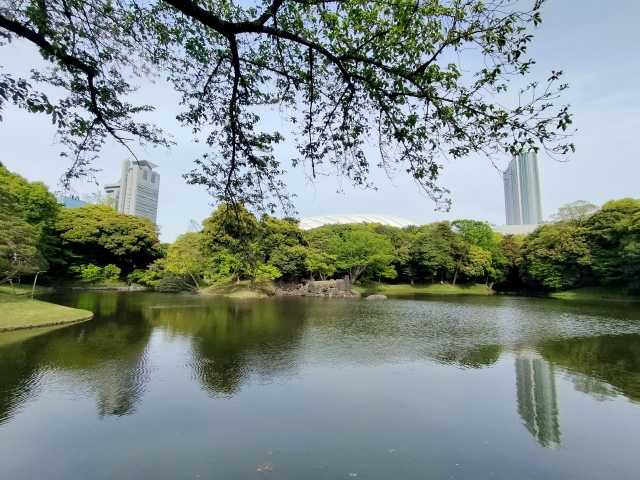
The Meiji, Taisho, and Showa eras, which saw changes and the birth of new famous gardens(1868~)
The Meiji Restoration brought about a complete change in the structure of society and the influx of Western culture. This brought about a new trend in the world of Japanese gardens, which until then had followed the traditions of the past.
On the other contrary, the elimination of temples, known as “abolition of Buddhism,” extended to gardens as well, and famous gardens were destroyed one after another.
Since the Meiji era, masters who left behind masterpieces with their own unique gardening techniques have left behind new values of Japanese gardens in the modern age.
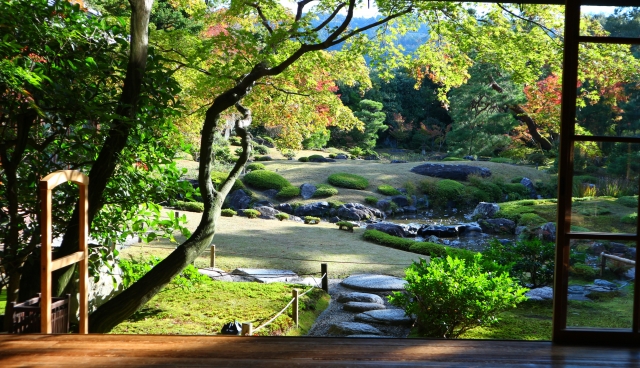
Jihei Ogawa VII, a.k.a. Ueji, who digested the garden views of Aritomo Yamagata, a politician and military officer, and devoted himself to creating new landscapes.
Mirei Shigemori measured and surveyed more than 300 old gardens throughout Japan, and based on his experience, created many gardens, including Tofukuji Temple in Kyoto. It was a time when many other outstanding garden designers came into the world.
The garden at the Adachi Museum of Art, which is rated the best in Japan by an American landscape architecture magazine, is another masterpiece created in the modern era.
Japanese gardens from the Meiji era onward inherited the world view of Japanese gardens that had been cultivated in previous eras, while at the same time embracing new values and creating new Japanese gardens without being confined to the existing framework. It was during this period that Japanese gardens gained global recognition and gained fans around the world. It was a time when Japanese garden culture, a symbol of Japanese culture, stepped up to a new stage.

References
Shozo Tanaka.How to Understand Japanese Gardens. JTB Publishing. 2007.
Miyamoto Kenji. Points of Japanese Garden Viewing 55. 2010 Mates Publishing Co.
Tatsuhiko Udagawa,Masaki Horiuchi. How to see and enjoy Japanese gardens. Ie no Hikari Kyokai. 2015
